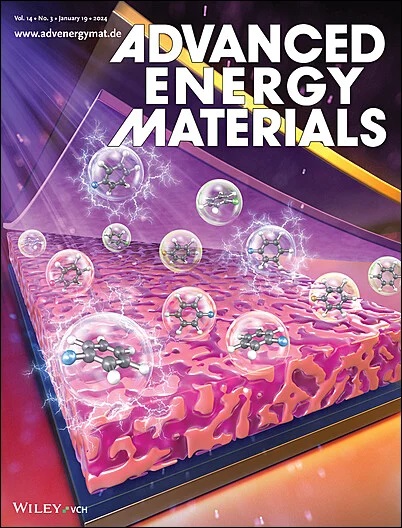Discerning Performance Bottlenecks of State-of-the-Art Narrow Bandgap Organic Solar Cells
IF 24.4
1区 材料科学
Q1 CHEMISTRY, PHYSICAL
引用次数: 0
Abstract
Discerning loss mechanisms in organic solar cells with narrow optical bandgap is critical for the development of conventional and next-generation photovoltaic technologies, especially for tandem and semi-transparent solar cells. Here, all photocurrent losses are quantitatively deconvoluted in two low-bandgap (Eg≈1.23 eV) binary systems using structurally analogous non-fullerene acceptors (NFAs), namely BTPV-4F-eC9 and BTPV-4Cl-eC9. Bias-dependent free charge generation and photoluminescence studies pinpoint geminate charge transfer (CT) state recombination as the predominant photocurrent limitation in both systems, compared to parent Y6-blends. Transient absorption spectroscopy too reveals a critical competition between CT decay and separation dynamics. Theoretical calculations uncover multiple stable molecular conformers that restrict NFA aggregation, aligning with morphological studies, resulting in poor CT separation in photoactive blends. Owing to CT loss pathways, free charge recombination in both low-bandgap systems is closer to the Langevin limit than in PM6:Y6. Nonetheless, they exhibit overall voltage losses of ≈0.56 V comparable to PM6:Y6, and efficient exciton dissociation despite a lower driving force. Current–voltage simulations show that suppressing geminate losses can vitally balance recombination pathways to unlock photocurrent potential of low-bandgap blends. Further optimization of the charge carrier mobility would push the PCE >16%, moving the internal quantum efficiency toward the detailed balance limit.

最先进的窄带隙有机太阳能电池性能瓶颈识别
识别窄光带隙有机太阳能电池的损耗机制对于传统和下一代光伏技术的发展,特别是串联和半透明太阳能电池的发展至关重要。在这里,所有的光电流损耗在两个低带隙(Eg≈1.23 eV)二元系统中被定量地反卷积,使用结构类似的非富勒烯受体(nfa),即BTPV-4F-eC9和BTPV-4Cl-eC9。偏置相关的自由电荷产生和光致发光研究指出,与母体y6 -共混物相比,这两种体系的主要光电流限制是生态电荷转移(CT)态重组。瞬态吸收光谱也揭示了CT衰减和分离动力学之间的关键竞争。理论计算揭示了限制NFA聚集的多种稳定分子构象,与形态学研究一致,导致光活性共混物的CT分离不良。由于CT损耗通路的存在,两种低带隙体系中的自由电荷复合都比PM6:Y6更接近朗格万极限。尽管如此,与PM6:Y6相比,它们的总电压损失约为0.56 V,尽管驱动力较低,但激子解离效率较高。电流-电压模拟表明,抑制双生损耗可以平衡复合途径,从而释放低带隙共混物的光电流势。进一步优化载流子迁移率将使PCE达到16%,将内部量子效率推向详细平衡极限。
本文章由计算机程序翻译,如有差异,请以英文原文为准。
求助全文
约1分钟内获得全文
求助全文
来源期刊

Advanced Energy Materials
CHEMISTRY, PHYSICAL-ENERGY & FUELS
CiteScore
41.90
自引率
4.00%
发文量
889
审稿时长
1.4 months
期刊介绍:
Established in 2011, Advanced Energy Materials is an international, interdisciplinary, English-language journal that focuses on materials used in energy harvesting, conversion, and storage. It is regarded as a top-quality journal alongside Advanced Materials, Advanced Functional Materials, and Small.
With a 2022 Impact Factor of 27.8, Advanced Energy Materials is considered a prime source for the best energy-related research. The journal covers a wide range of topics in energy-related research, including organic and inorganic photovoltaics, batteries and supercapacitors, fuel cells, hydrogen generation and storage, thermoelectrics, water splitting and photocatalysis, solar fuels and thermosolar power, magnetocalorics, and piezoelectronics.
The readership of Advanced Energy Materials includes materials scientists, chemists, physicists, and engineers in both academia and industry. The journal is indexed in various databases and collections, such as Advanced Technologies & Aerospace Database, FIZ Karlsruhe, INSPEC (IET), Science Citation Index Expanded, Technology Collection, and Web of Science, among others.
 求助内容:
求助内容: 应助结果提醒方式:
应助结果提醒方式:


